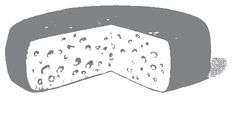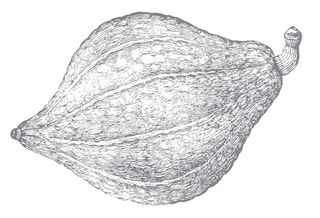Food Rules (3 page)
Authors: Michael Pollan

2
Don’t eat anything your great-grandmother wouldn’t recognize as food.
Imagine your great-grandmother (or grandmother, depending on your age) at your side as you roll down the aisles of the supermarket. You’re standing together in front of the dairy case. She picks up a package of Go-GURT Portable Yogurt tubes—and hasn’t a clue what this plastic cylinder of colored and flavored gel could possibly be. Is it a food or is it toothpaste? There are now thousands of foodish products in the s upermarket that our ancestors simply wouldn’t recognize as food. The reasons to avoid eating such complicated food products are many, and go beyond the various chemical additives and corn and soy derivatives they contain, or the plastics in which they are typically packaged, some of which are probably toxic. Today foods are processed in ways specifically designed to get us to buy and eat more by pushing our evolutionary buttons—our inborn preferences for sweetness and fat and salt. These tastes are difficult to find in nature but cheap and easy for the food scientist to deploy, with the result that food processing induces us to consume much more of these rarities than is good for us. The great-grandma rule will help keep most of these items out of your cart.
Note: If your great-grandmother was a terrible cook or eater, you can substitute someone else’s g randmother—a Sicilian or French one works particularly well.
The next several rules refine this strategy by helping you navigate the treacherous landscape of the ingredients label.
3
Avoid food products containing ingredients that no ordinary human would keep in the pantry.
Ethoxylated diglycerides? Cellulose? Xanthan gum? Calcium propionate? Ammonium sulfate? If you wouldn’t cook with them yourself, why let others use these ingredients to cook for you? The food scientists’ chemistry set is designed to extend shelf life, make old food look fresher and more appetizing than it really is, and get you to eat more. Whether or not any of these additives pose a proven hazard to your health, many of them haven’t been eaten by humans for very long, so they are best avoided.

4
Avoid food products that contain high-fructose corn syrup.
Not because high-fructose corn syrup (HFCS) is any worse for you than sugar, but because it is, like many of the other unfamiliar ingredients in packaged foods, a reliable marker for a food product that has been highly processed. Also, high-fructose corn syrup is being added to hundreds of foods that have not traditionally been sweetened—breads, condiments, and many snack foods—so if you avoid products that contain it, you will cut down on your sugar intake. But don’t fall for the food industry’s latest scam: products reformulated to contain “no HFCS” or “real cane sugar.” These claims imply these foods are somehow healthier, but they’re not. Sugar is sugar.

5
Avoid foods that have some form of sugar (or sweetener) listed among the top three ingredients.
Labels list ingredients by weight, and any product that has more sugar than other ingredients has too much sugar. (For an exception to this rule, see rule 60, regarding special occasion foods.) Complicating matters is the fact that, thanks to food science, there are now some forty types of sugar used in processed food, including barley malt, beet sugar, brown rice syrup, cane juice, corn sweetener, dextrin, dextrose, fructo-oligosaccharides, fruit juice concentrate, glucose, sucrose, invert sugar, polydextrose, sucrose, turbinado sugar, and so on. To repeat: Sugar is sugar. And organic sugar is sugar too. As for noncaloric sweeteners such as aspartame or Splenda, research (in both humans and animals) suggests that switching to artificial sweeteners does not lead to weight loss, for reasons not yet well understood. But it may be that deceiving the brain with the reward of sweetness stimulates a craving for even more sweetness.
6
Avoid food products that contain more than five ingredients.
The specific number you adopt is arbitrary, but the more ingredients in a packaged food, the more highly processed it probably is. Note 1: A long list of ingredients in a recipe is not the same thing; that’s fine. Note 2: Some products now boast, somewhat deceptively, about their short ingredient lists. Häagen-Dazs has a new line of ice cream called “five.” Great—but it’s still ice cream. Same goes for the three-ingredient Tostitos corn chips advertised by Frito-Lay—okay, but they’re still corn chips. In such cases, apply rule 60 for dealing with treats and special occasion foods.

7
Avoid food products containing ingredients that a third-grader cannot pronounce.
Basically the same idea, diffeent mnemonic. Keep it simple!

8
Avoid food products that make health claims.
This sounds counterintuitive, but consider: For a product to carry a health claim on its package, it must first have a package, so right off the bat it’s more likely to be a processed rather than a whole food. Then, only the big food manufacturers have the where-withal to secure FDA-approved health claims for their products and then trumpet them to the world. Generally, it is the products of modern food science that make the boldest health claims, and these are often founded on incomplete and often bad science. Don’t forget that margarine, one of the first industrial foods to claim it was more healthful than the traditional food it replaced, turned out to contain transfats that give people heart attacks. The healthiest food in the supermarket—the fresh produce—doesn’t boast about its healthfulness, because the growers don’t have the budget or the packaging. Don’t take the silence of the yams as a sign they have nothing valuable to say about your health.

9
Avoid food products with the wordoid “lite” or the terms “low-fat” or “nonfat” in their names.
The forty-year-old campaign to create low-and nonfat versions of traditional foods has been a failure: We’ve gotten fat on low-fat products. Why? Because removing the fat from foods doesn’t necessarily make them nonfattening. Carbohydrates can also make you fat, and many low- and nonfat foods boost the sugars to make up for the loss of flavor. Also, by de monizing one nutrient—fat—we inevitably give a free pass to another, supposedly “good,” nutrient—carbohydrates in this case—and then proceed to eat too much of that instead. Since the low-fat campaign began in the late 1970s, Americans actually have been eating more than 500 additional calories per day, most of them in the form of refined carbohydrates like sugar. The result: The average male is seventeen pounds heavier and the average female nineteen pounds heavier than in the late 1970s. You’re better off eating the real thing in moderation than bingeing on “lite” food products packed with sugars and salt.
10
Avoid foods that are pretending to be something they are not.
Imitation butter—aka margarine—is the classic example. To make something like nonfat cream cheese that contains neither cream nor cheese requires an extreme degree of processing; such products should be labeled as imitations and avoided. The same rule applies to soy-based mock meats, artificial sweeteners, and fake fats and starches.

11
Avoid foods you see advertised on television.
Food marketers are ingenious at turning criticisms of their products—and rules like these—into new ways to sell slightly different versions of the same processed foods: They simply reformulate (to be low-fat, have no HFCS or transfats, or to contain fewer ingredients) and then boast about their implied healthfulness, whether the boast is meaningful or not. The best way to escape these marketing ploys is to tune out the marketing itself, by refusing to buy heavily promoted foods. Only the biggest food manufacturers can afford to advertise their products on television: More than two thirds of food advertising is spent promoting processed foods (and alcohol), so if you avoid products with big ad budgets, you’ll automatically be avoiding edible foodlike substances. As for the 5 percent of food ads that promote whole foods (the prune or walnut growers or the beef ranchers), common sense will, one hopes, keep you from tarring them with the same brush—these are the exceptions that prove the rule.
Other books
The Bride Hunt by Jane Feather
The Queen of the Dead by Vincenzo Bilof
The Very Best Gift by CONNIE NEAL
The Price of Love and Other Stories by Peter Robinson
The Cowboys Heart 1 by Helen Evans
The Turncoat by Thorland, Donna
Heart of a Stripper by Harris, Cyndi
The Boss's Pet: Their Submissive Switch by Kinzer, Tonya
Taking the Fall by W. Ferraro
The Pale Blue Eye: A Novel by Louis Bayard
